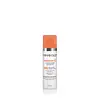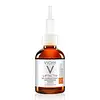What's inside
What's inside
 Key Ingredients
Key Ingredients

 Benefits
Benefits

 Concerns
Concerns

 Ingredients Side-by-side
Ingredients Side-by-side

Dimethicone
EmollientAscorbic Acid
AntioxidantPolysilicone-11
Caprylyl Caprylate/Caprate
EmollientIsohexadecane
EmollientPentylene Glycol
Skin ConditioningPEG-10 Dimethicone
Skin ConditioningTocopheryl Acetate
AntioxidantButyrospermum Parkii Butter
Skin Conditioning4-T-Butylcyclohexanol
MaskingEthylene/Propylene/Styrene Copolymer
Butylene/Ethylene/Styrene Copolymer
Sodium Hyaluronate
HumectantTripeptide-1
Skin ConditioningXanthan Gum
EmulsifyingPhenoxyethanol
PreservativeParfum
MaskingDimethicone, Ascorbic Acid, Polysilicone-11, Caprylyl Caprylate/Caprate, Isohexadecane, Pentylene Glycol, PEG-10 Dimethicone, Tocopheryl Acetate, Butyrospermum Parkii Butter, 4-T-Butylcyclohexanol, Ethylene/Propylene/Styrene Copolymer, Butylene/Ethylene/Styrene Copolymer, Sodium Hyaluronate, Tripeptide-1, Xanthan Gum, Phenoxyethanol, Parfum
Water
Skin ConditioningAscorbic Acid
AntioxidantGlycerin
HumectantSodium Hydroxide
BufferingPentylene Glycol
Skin ConditioningLaureth-23
CleansingHaematococcus Pluvialis Extract
AntioxidantCarnosine
Skin ConditioningNeohesperidin Dihydrochalcone
MaskingSodium Hyaluronate
HumectantTrisodium Ethylenediamine Disuccinate
Tocopherol
AntioxidantDipotassium Glycyrrhizate
HumectantCaprylic/Capric Triglyceride
MaskingCaprylyl Glycol
EmollientCarrageenan
Phenoxyethanol
PreservativeWater, Ascorbic Acid, Glycerin, Sodium Hydroxide, Pentylene Glycol, Laureth-23, Haematococcus Pluvialis Extract, Carnosine, Neohesperidin Dihydrochalcone, Sodium Hyaluronate, Trisodium Ethylenediamine Disuccinate, Tocopherol, Dipotassium Glycyrrhizate, Caprylic/Capric Triglyceride, Caprylyl Glycol, Carrageenan, Phenoxyethanol
 Reviews
Reviews

Ingredients Explained
These ingredients are found in both products.
Ingredients higher up in an ingredient list are typically present in a larger amount.
Ascorbic Acid is is pure Vitamin C. This form makes up the largest amount of vitamin C found naturally in our skin.
Not only is vitamin C great for your overall health and immune system, it also has plenty of benefits on your skin.
Vitamin C is best used for brightening skin. It improves dark spots, acne scars, and hyperpigmentation. This is because it blocks the process of skin darkening when exposed to UV.
Remember: Vitamin C should not replace sunscreen!
Your skin uses vitamin C to build collagen. Collagen is one key component in having a strong skin barrier and plump skin. Vitamin C also plays a role in regulating collagen, thus making it effective in improving wrinkles and fine lines.
Ascorbic acid shows potent antioxidant activity. As an antioxidant, it helps fight free-radicals. Free-radicals are molecules that may damage your skin cells. These antioxidants also protect skin against UV damage.
The best formulations include Vitamin E and/or ferulic acid. These two ingredients help stabilize and provide a boost in the benefits of ascorbic acid. This is because ascorbic acid becomes unstable when exposed to UV and air. In fact, you can tell your ascorbic acid has oxidized when it turns an orange-yellow color.
Ascorbic acid is generally compatible with other ingredients. However, using ascorbic acid with other active ingredients might cause irritation. Two ingredients: copper ions and benzoyl peroxide, will inactivate ascorbic acid completely.
Read more about other types of Vitamin C:
Foods rich with vitamin C include oranges, strawberries, broccoli, bell peppers, and more. When consuming Vitamin C, your skin receives a portion of the nutrients.
Learn more about Ascorbic AcidPentylene glycol is typically used within a product to thicken it. It also adds a smooth, soft, and moisturizing feel to the product. It is naturally found in plants such as sugar beets.
The hydrophilic trait of Pentylene Glycol makes it a humectant. As a humectant, Pentylene Glycol helps draw moisture from the air to your skin. This can help keep your skin hydrated.
This property also makes Pentylene Glycol a great texture enhancer. It can also help thicken or stabilize a product.
Pentylene Glycol also acts as a mild preservative and helps to keep a product microbe-free.
Some people may experience mild eye and skin irritation from Pentylene Glycol. We always recommend speaking with a professional about using this ingredient in your routine.
Pentylene Glycol has a low molecular weight and is part of the 1,2-glycol family.
Learn more about Pentylene GlycolPhenoxyethanol is a preservative that has germicide, antimicrobial, and aromatic properties. Studies show that phenoxyethanol can prevent microbial growth. By itself, it has a scent that is similar to that of a rose.
It's often used in formulations along with Caprylyl Glycol to preserve the shelf life of products.
Sodium Hyaluronate is hyaluronic acid's salt form. It is commonly derived from the sodium salt of hyaluronic acid.
Like hyaluronic acid, it is great at holding water and acts as a humectant. This makes it a great skin hydrating ingredient.
Sodium Hyaluronate is naturally occurring in our bodies and is mostly found in eye fluid and joints.
These are some other common types of Hyaluronic Acid:
Learn more about Sodium Hyaluronate